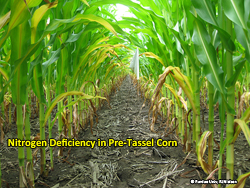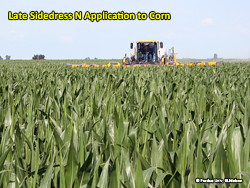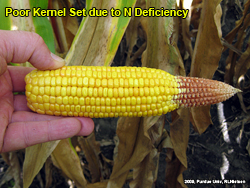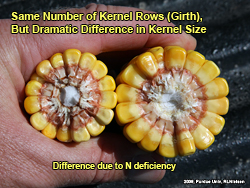15 June 2011
URL: http://www.kingcorn.org/news/timeless/CornRespLateSeasonN.html
Response of Corn to Late-season Nitrogen Application
Eric Miller, R.L. (Bob) Nielsen, and Jim Camberato
Agronomy Dept., Purdue Univ.
West Lafayette, IN 47907-2054
Email addresses: millerec@purdue.edu, rnielsen@purdue.edu, jcambera@purdue.edu
![]() itrogen (N) fertilizer is a crucial input for maximizing yield and profitability of corn. The expense and environmental impact of N fertilizer has heightened the need for efficient N management practices. A sidedress application of N fertilizer is one option to improve N use efficiency by reducing the risk of N loss prior to plant uptake. However, wet field conditions during times of planned sidedress applications can seriously delay the timing of the application. Thus a concern arises as to the impact of later-applied N on corn yield, profit, and fertilizer N efficiency. In the Eastern Corn Belt, little research has been conducted on the consequences of delayed N application on corn yield and profitability or environmental impacts.
itrogen (N) fertilizer is a crucial input for maximizing yield and profitability of corn. The expense and environmental impact of N fertilizer has heightened the need for efficient N management practices. A sidedress application of N fertilizer is one option to improve N use efficiency by reducing the risk of N loss prior to plant uptake. However, wet field conditions during times of planned sidedress applications can seriously delay the timing of the application. Thus a concern arises as to the impact of later-applied N on corn yield, profit, and fertilizer N efficiency. In the Eastern Corn Belt, little research has been conducted on the consequences of delayed N application on corn yield and profitability or environmental impacts.
In 2010, we initiated a 13-acre field-scale experiment at the Pinney-Purdue Agricultural Center near Wanatah, Indiana to address these questions. The previous crop was soybean. The trial was planted on April 22 directly following cultivation resulting in an ideal seedbed, excellent seed to soil contact, and good seed germination. Seedlings emerged uniformly and plants developed uniformly throughout the growing season. All plots received an initial 24 lbs N/acre as starter fertilizer during planting.
In this trial, 28% urea-ammonium nitrate was sidedressed at either V7 (defined by 7 visible leaf collars) or V15 growth stages at 0, 40, 80, 120, 160, and 200 lbs actual N/acre. The late N application was intended to occur at V12, but weather and an equipment malfunction delayed the application until V15. A traditional knife injection tool bar was utilized at V7, whereas a Hagie® high clearance sprayer with a mounted coulter-injection toolbar was used at V15. During the 14 days preceding the V15 application, over four inches of rain were recorded at the weather station near this field. However, significant rainfall did not occur until 11 days after the V15 N application.
At silking, total above-ground dry matter and N content was the same whether the corn had received only starter N or starter N plus 200 lbs/ac N at V15. Nitrogen stress was obvious in both treatments with leaves fired up to the ear. The fact that little rainfall had occurred between the V15 application and silking undoubtedly contributed to the lack of response to the extra N by this point in time. Not until four weeks after silking (R4 stage – kernel dough stage) did the corn show evidence of responding to the N applied at V15 in terms of increased aboveground biomass accumulation when compared to the starter-only control.
Total number of ovules (pollinated or not) were counted at growth stage R2 (kernel blister stage). These numbers reflect the potential number of kernels. The number of potential kernels was similar between the V15 and starter-only treatments (Fig. 1). However, potential kernel numbers for both of these treatments were approximately 9% fewer than the V7 treatment. At this point, 20 days after the V15 sidedress application, the V15 sidedress plots showed no visual differences versus plots that received only starter fertilizer.
At physiological maturity, the number of harvestable kernels for the V15 sidedress treatment was only 6% less than for the V7 sidedress treatment, but 28% greater than for the starter-only control (Fig. 1). Kernel weights were nearly identical for the V7 and V15 sidedress treatments. One can conclude that the yield differences among these sidedress treatments were due to a combination of effects that occurred during ear size determination and on kernel survival during grain fill.
At harvest, the V15 sidedressed plots yielded 100 bu/acre more than the starter-only control and only 13 bu/acre less than the traditional V7 sidedress timing (Fig. 2). Most of the 13 bu/acre difference in grain yield between the two sidedress timings was due to differences in kernel number per ear at harvest (Fig 1). The agronomic optimum N rates for the two sidedress timings were similar (188 vs 178 for V7 and V15, respectively).
In 2007, a similar study was conducted at the same location with similar results. Nitrogen fertilizer sidedress-applied at growth stage V13 increased yield 64 bu/acre compared to the starter-only control, but yield was 18 bu/acre less than an earlier V3 sidedress treatment (Emmert, 2009). In both studies, corn plants were visibly N deficient but otherwise healthy due to excellent growing conditions throughout the season. Good uniform stands, healthy plants and established root systems likely contributed to the substantial benefit of N fertilizer applied late in the season.
The results of these studies demonstrate that corn can recover from significant N deficiency stress with applications of sidedress N fertilizer even as late as V13 to V15. In a year when weather can delay field work into unconventional periods of the growing season, options still remain to recover significant yield with late sidedress N applications.
The caveat to these promising results is that when N deficiency occurs due to saturated soils and ponding of fields, the resulting stands of corn are often also compromised due to root damage caused by the excessive soil moisture. Under these more challenging conditions, corn may not respond as strongly to late applied N. Consequently, previous recommendations from Purdue suggested no more than 60 lbs N/acre be applied to severely N deficient corn late during the vegetative period (Brouder and Mengel, 2003).
One last comment we would make regarding sidedress application equipment for late growth stages is that while our trial used a high-clearance applicator equipped with a mounted coulter-injection toolbar, similar high-clearance applicators equipped with drop nozzles could also be used with minimal risk of N loss by volatilization within a closed crop canopy. One should take care to weight the drop nozzles to minimize their swaying and bouncing and, thus, minimize the amount of liquid N splashed on plant tissue that would cause significant leaf damage. Dribbling liquid N on the soil surface in this manner would also be more dependent on soil moisture or subsequent rainfall to move the N into the soil for plant uptake.
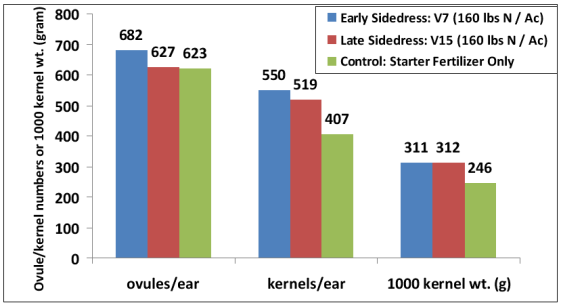
Fig. 1. Influence of timing and rate of N fertilizer on yield components of corn. Starter-only treatments
consisted of 24 lbs N / ac. Sidedress rates were in addition to 24 lbs N / ac applied as starter at
planting. Pinney-Purdue Ag Center, 2011.
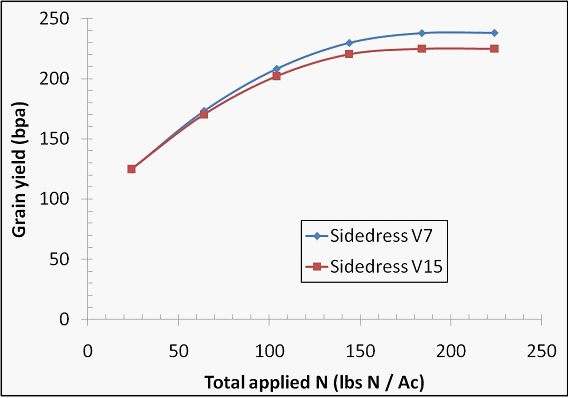
Fig. 2. Influence of N rates and sidedress timing on grain yield of corn. The total applied rates of N
included 24 lbs N / ac applied as starter at
planting (left-most data point represents only starter fertilizer).
Pinney-Purdue Ag Center, 2011.
Related References
Brouder, S.M. , and D.B. Mengel. 2003. Determining nitrogen fertilizer sidedress application needs in corn using a chlorophyll meter. Purdue Univ. Extension publication AY-317_W. Online at http://www.agry.purdue.edu/ext/pubs/AY-317-W.pdf [URL accessed June 2011].
Camberato, Jim, RL (Bob) Nielsen, and Brad Joern. 2011. Assessing Available Nitrogen from Fall- and Spring-Applied Nitrogen Applications. Corny News Network, Purdue Univ. Extension. Online at http://www.kingcorn.org/news/timeless/AssessAvailableN.html. [URL accessed June 2011].
Camberato, Jim, RL (Bob) Nielsen, Eric Miller, and Brad Joern. 2011. Nitrogen Management Guidelines for Indiana. Purdue Univ. Extension Applied Crop Research Update. Online at http://www.kingcorn.org/news/timeless/NitrogenMgmt.pdf [URL accessed June 2011].
Emmert, D. 2009. Using canopy reflectance to monitor corn response to nitrogen and the effects of delayed nitrogen application. Master’s Thesis. Purdue University.
Scharf, Peter. 2009. Nitrogen Loss: Again??!! Univ. of Missouri Integrated Pest & Crop Management Newsletter. Online at http://ppp.missouri.edu/newsletters/ipcm/archives/fullissue/v19n13.pdf [URL accessed June 2011].
Thomison, Peter and Robert Mullen. 2010. "Late" Applications of Nitrogen to Corn. Ohio State Univ. Extension C.O.R.N. Newsletter. Online at http://agcrops.osu.edu/corn/newsletters/2010/2010-17/late-applications-of-nitrogen-to-corn [URL accessed June 2011].

